Corporate Guide
History of the Takara Group
-

-
- Chapter 4
-
Building an Infrastructure for Corporate Growth
1993–2021
Establishing a group management system and expanding biomedical and overseas businesses
-
-
1
Reforms and transition to group management
-
1993
-
Hisashi Ohmiya appointed Takara Shuzo’s ninth president, accelerates the pace of reforms
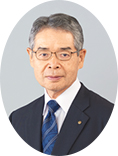
In 1993, Hisashi Ohmiya (photo) was appointed as Takara Shuzo’s 9th president. That same year, the company formulated TI-21 (Takara Innovation-21), a long-term management plan for the 21st century. It clearly set out the company's policy to become an excellent company in the 21st century by pursuing long-term stable profits and simultaneously achieving corporate prosperity, employee happiness, and harmony with nature and society.
-

1993
-
High-value-added products boost competitiveness
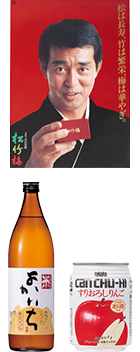
As consumers' tastes continue to diversify, Takara Shuzo poured its energies into developing products with high added value. In the field of sake, Tanrei Karakuchi, a sake of unprecedented quality, was achieved by the adoption of a rice roasting method. Meanwhile, actor Tetsuya Watari (photo top) was signed on as the face of Sho Chiku Bai sake, further bolstering the position of Sho Chiku Bai in the celebratory gift market. In 1993, the company made a full-fledged entry into the Class B (otsurui) shochu market with the launch of Honkaku Kome Shochu Yokaichi (photo left). In addition, the introduction of the Takara Can Chu-Hi Deluxe series succeeded in creating a new market, this time for sweet-flavored chu-hi products. In particular, the 1994 launch of the first-ever product containing fruit pulp—the apple-flavored Takara Can Chu-Hi Deluxe Surioroshi Ringo (photo right)—was a hit, assisted by its quality and a TV advertisement campaign featuring actress Rie Miyazawa.
-

2000
-
Revision of the long-term management plan and corporate philosophy
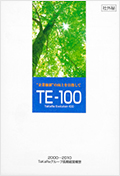
In 2000, Takara Shuzo formulated the long-term management plan "TE-100" (Takara Evolution-100) in response to changes in business fundamentals, such as shrinking of the drinking population due to the declining birthrate and the deregulation of liquor retail licenses (abolition of restrictions based on distance and population). Takara Evolution-100’s stated goal was to improve corporate value, and it set the aim of management based on the customer’s perspective, respect for fellow humans, and harmony with society and the natural environment. The following year, in 2001, Takara Shuzo updated its corporate philosophy. The new philosophy was stated to be contributing to the creation of a vital society and a healthy lifestyle through the company's fermentation technology and biotechnology in a way that achieves harmony with nature. (Photo: "TE-100" pamphlet presenting the company's long-term management plan)
-

2002
-
Splitting off the company's alcohol and biomedical businesses
On April 1, 2002, Takara Shuzo Co., Ltd. changed its name to Takara Holdings, Inc. and became a holding company. Further, two operating companies were incorporated as subsidiaries to Takara Holdings: a new Takara Shuzo Co., Ltd., to handle the group’s mainstay liquor, food, and raw alcohol business, and Takara Bio, Inc., to handle the biomedical side of the business.
-
-
1
-
-
2
The expanding role of biotechnology
-
1993
-
The PCR method generates new business opportunities
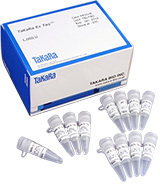
The 1990s were a time when the biomedical business flourished. In 1993, for instance, the biomedical business division obtained broad-ranging global licenses to use patents relating to polymerase chain reaction (PCR) methods, and began to manufacture PCR-based products. In 1996, the company obtained patent rights to long and accurate polymerase chain reaction (LA-PCR) methods. The new LA-PCR technology was so well received in the market that licenses for its use were issued to most bio-research reagent manufacturers in Japan and overseas. (Photo: TaKaRa EX Taq™, a product based on LA-PCR technology)
-

1993
-
Dalian Plant marks the start of overseas expansion

The biomedical business division, which had grown the genetic engineering research business into a core business, established the Bio Products Development Center in Kusatsu, Shiga Prefecture in 1990. In anticipation of full-scale competition in this market, in 1993, the company established Takara Biotechnology (Dalian) in Dalian, China (photo), and transferred manufacturing from Japan to the new company for the stable production of high-quality products. In addition, to bolster its overseas distribution network,Takara Shuzo established two subsidiaries to handle sales of the company’s research reagents: Takara Biomedical Europe (presently Takara Bio Europe) and Bohan Biomedical (presently Takara Korea Biomedical).
-

1996
-
Focus on the functions of Japan's traditional foods
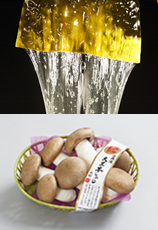
As people become more health-conscious, research and development focusing on the functions of foods are advancing. In 1996, research led to the discovery that U-fucoidan contained in gagome kombu (kelp) induces apoptosis (programmed cell death) in cancer cells. In 1998, it was discovered that agarooligosaccharides, natural oligosaccharides derived from agar, help to suppress cancer. A further discovery—that chalcone derived from ashitaba (angelica herb) may be effective in the treatment of osteoporosis and diabetes-induced disorders of the peripheral nervous system—spurred the establishment of ashitaba production facilities on Yakushima Island in Kagoshima and elsewhere. Meanwhile, in the field of mushroom cultivation, Takara Shuzo succeeded in the large-scale production of honshimeji for the first time in Japan. Subsequently, honshimeji produced on a large scale by Mizuho Norin, were awarded the Kyoto Brand Products status by the Kyoto Prefectural Government in 2015. (Photo top: Gagome kombu; Photo bottom: Daikoku hon-shimeji)
-

1997
-
Entry into the gene therapy sector with RetroNectin®
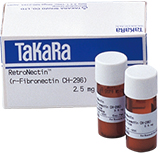
In 1994, Takara Shuzo obtained information from Indiana University that fibronectin appears to increase the efficiency of gene introduction, which led to a joint research project with Indiana University the following year. In time, the research team discovered that fibronectin dramatically improves the efficiency of gene introduction into hematopoietic stem cells. In 1997, the company launched RetroNectin® (photo), a reagent for gene therapy research, worldwide. RetroNectin® was used at a pediatric hospital in France in gene therapy to treat a patient with congenital immunodeficiency. The treatment was a success and the news garnered worldwide attention.
-

2000
-
Establishment of Dragon Genomics

As genome sequencing progressed in Japan and overseas, in 2000, Takara Shuzo established Dragon Genomics Co., Ltd. (presently the Takara Bio Biomedical Center), one of the largest private-sector genome sequencing centers in Asia, in Yokkaichi, Mie Prefecture, and started offering sequencing services under contract. This facility has since gradually expanded its services to include basic research in areas such as DNA synthesis and antibody production, and today, the Takara Bio Biomedical Center performs the largest number of genetic tests in Japan. (Photo: Dragon Genomics Co., Ltd. at the time of its establishment)
-

2004
-
Takara Bio becomes a publicly traded company
In response to the significant changes in the market environment, Takara Bio, which had split off from Takara Shuzo, announced its plan to focus its management resources in three core areas: genetic engineering, gene therapy, and agribio. In 2004, the company's shares were listed on the Mothers Section of the Tokyo Stock Exchange, further underlining the company’s status as an independent business entity.
2004
-
Takara Bio’s four-hub global network
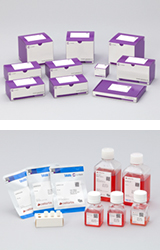
Amidst increasingly fierce global competition, the company established Takara Biomedical Technology (Beijing) in 2004. The following year, Takara Bio acquired Clontech (presently Takara Bio USA) as a partner company to strengthen its genetic engineering research operations. In 2011, Takara Bio established DSS Takara Bio India to gain a foothold in the Indian market, and in 2014, acquired Swedish company Cellartis and established Takara Bio Europe AB, thereby creating a four-hub R&D network spread across Japan, the U.S., Europe, and China. (Photo top: Clontech brand products; Photo bottom: Cellartis brand products)
-

-
-
2
-
-
3
Development and growth for product differentiation
-
2001
-
Shirakabegura and Ten: The perfect offerings for a polarized sake market
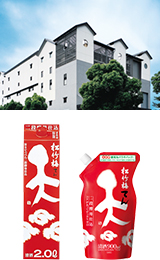
Since the 1990s, the sake market had been largely polarized between "special class" sake such as ginjo at one extreme and low-cost sake in paper cartons at the other. In 2001, the Nada Plant was upgraded to create Shochikubai Shirakabegura (photo top), a high-quality sake brewery capable of producing truly delicious sake. The plant began producing a succession of high quality and unique products such as Sho Chiku Bai Shirakabegura Kimoto Junmai, brewed according to the traditional, painstaking kimoto method. On the other hand, in the soft pack market, the company released Sho Chiku Bai Ten (photo bottom left), which was produced using a two-stage fermentation process, in 2003. These products earned the company the support of many users and broke new ground. A further breakthrough in value came in 2011, when Sho Chiku Bai Ten was launched in eco pouches (photo bottom right) that offered easier storage and disposal.
-

2001
-
Launch of Ikkomon, a 100% sweet potato-based shochu
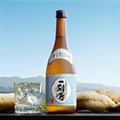
In 2001, as a new single-distilled (honkaku) shochu to follow in the footsteps of Yokaichi, Takara Shuzo developed a new product made entirely from sweet potatoes and designed to bring out their intrinsic flavor characteristics. This product was named Ikkomon (photo), a term in the local dialect of Kagoshima meaning someone who is uncompromising and stubbornly dedicated. Then in 2007, the company launched Gokujo Takara Shochu. In 2008, Takara Shuzo launched Shirashinken, a honkaku shochu distilled from barley, and in 2013, it launched Ikkomon Aka, a honkaku shochu distilled entirely from red sweet potatoes, among other products, actively promoting the revitalization of the shochu market.
-

2006
-
Takara Shochu Highball launches

In 2006, Takara Shochu Highball (photo), which revived the flavor of the original chu-hi, was released. Steadfast sales efforts gradually generated success cases, and in 2009, as all these individual successes began coming together, an advertising campaign touting the distinctive dry flavor of Takara Shochu Highball under the slogan of "the delicious taste of the working-class bar" was launched, resulting in a full-fledged market breakthrough and sales growth that endures to this day.
-

2006
-
Withdrawal from non-alcoholic beverages, restructuring of health food operations
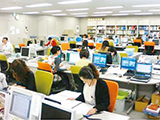
In 2006, a new company, Takara Healthcare, was established as a wholly-owned subsidiary of Takara Holdings in a move designed to maximize the synergies of Takara Shuzo’s beverage and functional food businesses and Takara Bio’s agribio business. By handling the sale of health foods developed by Takara Bio, Takara Healthcare freed up Takara Bio to concentrate on its core business of research and product development Meanwhile, Takara Shuzo withdrew from the non-alcoholic beverage business but retained a deep wealth of marketing and sales expertise which would stand its new endeavors in good stead and promote the growth of health food operations throughout the Takara Group. (Photo: The call center of Takara Healthcare)
-

2006
-
Aiming to cultivate the ready-prepared meals market and away-from-home meals market
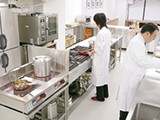
In 2006, Takara Shuzo established its Seasoning Processing Business Division with the aim of cultivating the growing market for ready-prepared meals and the away-from-home meals market. The division’s technical support backbone came from customer support centers newly opened in east and west Japan. In 2011, Takara Shuzo established the Seasoning and Raw Alcohol Division so as to bolster its B-to-B business and establish it as another pillar to underpin the group’s operations in the future. To meet diversifying needs for seasonings, the company works on developing and nurturing differentiated products such as soup stock seasonings and functional seasonings. (Photo: East Japan Seasonings Customer Center)
-

-
-
3
-
-
4
Building an infrastructure for corporate growth
-
1995
-
Expansion of the overseas liquor business and full-scale entry into the overseas Japanese food ingredients wholesale business

As the globalization of economies continues at an accelerating pace, Takara Shuzo has been expanding overseas operations through two main initiatives: The "overseas liquor business" that exports Takara Shuzo products and manufactures and sells them locally; and the "overseas Japanese food ingredients wholesale business" that sells Japanese food ingredients to Japanese restaurants and retail stores overseas. In the overseas liquor business, following the establishment of Takara Sake USA, Takara Shuzo established Beijing Takara Foods (presently Takara Shuzo Foods) (photo top) in 1995. Takara Shuzo began to produce and sell sake, mirin, and shochu in China. In the overseas Japanese food ingredients wholesale business, Takara Shuzo entered the European market, where Japanese food is increasingly popular, in earnest in 2010 with Foodex (photo bottom), the largest Japanese food ingredients wholesaler in France, as a partner.
-

2011
-
Formulation of Takara Group Vision 2020, the Group's long-term management vision
In 2011, Takara Holdings formulated Takara Group Vision 2020, a long-term management vision leading up to the year 2020, and set the management goals of expanding business in markets where Takara can leverage its strengths in Japan and overseas, and establishing a well-balanced business structure that is resilient to changes in the business environment. It also clarified the path that the Takara Group should take, such as establishing a group management system, developing and nurturing distinctive, unrivaled products, and expanding biomedical and overseas businesses.
2011
-
Mio, the sparkling sake
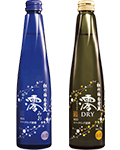
In 2011, Sho Chiku Bai Shirakabegura Mio (photo left) was born, opening up a new category, sparkling sake, in the sake market. Development of Mio started in the mid-2000s. Takara Shuzo developed its own manufacturing technology with the aim of creating a product that would appeal to light users not familiar with traditional sake. The result was a bubbly sake with a subtle sweetness and just the right hint of tartness. In 2015, Sho Chiku Bai Shirakabegura Mio Dry (photo right) joined the lineup.
-

2012
-
Toshio Kakimoto becomes the company’s tenth president
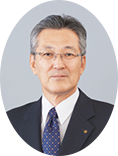
In June 2012, President Hisashi Ohmiya became chairman of the board and Toshio Kakimoto (photo) was appointed as the company’s tenth president. President Kakimoto vowed to carry on the business strategies promoted so far, such as the development of high value-added products, and to pursue further development from a long-term perspective. In addition, sakes such as Mio and Ten that won over new users. Takara Shochu as the No. 1 brand of korui shochu, and honkaku shochu centering on Ikkomon. Also, Japanese seasonings such as Takara Hon-Mirin. Through these many differentiated products and steadfast product nurturing, Takara Shuzo is making steady progress toward becoming the No. 1 Japanese alcohol company.
-

2013
-
Bringing Japanese food culture to the world
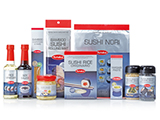
In 2013, washoku, or the traditional dietary culture of the Japanese was registered as an intangible cultural heritage by UNESCO, and as global interest in Japanese food continues to grow, Takara Shuzo is expanding its overseas Japanese food ingredients wholesale business. Takara Shuzo partnered with two companies in Europe, Tazaki Foods (U.K.) in 2013 and Cominport Distribución (Spain) in 2014, to form the largest Japanese food ingredients wholesale group in Europe. In addition, in 2012, Takara Shuzo acquired shares through third-party allocation in Mutual Trading, a long-standing partner in the U.S., thus strengthening those ties. (Photo: Japanese food ingredients under the Yutaka brand of Tazaki Foods)
-

2014
-
Contributing to better health through innovative biotechnologies

The award of the Nobel Prize to Prof. Shinya Yamanaka of the Kyoto University Center for iPS Cell Research and Application caused a spike of interest in regenerative medicine. Against this background, Takara Bio moved to strengthen its capabilities in this area by renaming its core business operations segment, from "genetic engineering business" to "bioindustry business." The company began expanding its Contract Development and Manufacturing Organization (CDMO) operations, which provide support from R&D to manufacturing for regenerative medicine related products and biopharmaceuticals. The core facility of these operations is the Center for Gene and Cell Processing (photo), which opened in Kusatsu, Shiga Prefecture, in 2014. Furthermore, in 2015, Takara Bio began consolidating its dispersed domestic development bases in Kusatsu to create a one-stop shop for contract services. Meanwhile, in the field of genetic medicine, work continues apace to conquer intractable diseases such as cancer through gene therapy. Takara Bio is involved in clinical development projects relating to the oncolytic virus HF10 to treat malignant melanoma, siTCR gene therapy to treat solid tumors, and CAR gene therapy to treat hematopoietic tumors.
-

2016
-
Listing of Takara Bio on the First Section of the Tokyo Stock Exchange
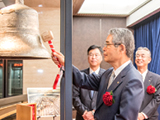
Takara Bio, which had been listed on the Mothers Section of the Tokyo Stock Exchange, changed its listing market to the First Section of the Tokyo Stock Exchange in March 2016. Based on its corporate philosophy of "Contributing to the health of humankind through the development of revolutionary biotechnologies such as gene therapy," the company aims for further growth by further expanding its business and enhancing its corporate value. (Photo: Ringing of the bell to mark the debut of Takara Bio on the First Section of the Tokyo Stock Exchange.)
-

2016
-
Establishing a global network of Japanese food ingredients wholesalers

Takara Shuzo, which is building a global network of Japanese food ingredients wholesalers, welcomed Portugal's Keta Foods Lda. as a partner in 2016, and further strengthened its partnership with U.S. Mutual Trading Co., Inc., taking it into the Takara Group as a consolidated company. (Photo: Exterior view of Mutual Trading building)
-

2017
-
Establishment of Takara Shuzo International
Takara Shuzo, which is rapidly expanding its business overseas, welcomed Australia's Nippon Food Supplies as a partner in 2017. Furthermore, it spun off its overseas business, which has a different business environment from the domestic business, establishing Takara Shuzo International Co., Ltd. on July 3 of the same year. To further accelerate the growth of its overseas business, the company is making faster and more accurate decisions and developing and strengthening its business infrastructure, including its global bases.
2018
-
Mutsumi Kimura becomes the 11th president of Takara Shuzo
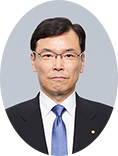
In June 2018, Mutsumi Kimura (photo) became Takara Shuzo’s 11th president. He aims to strengthen the group's structure to establish a well-balanced business structure that is resilient to changes in the environment, based on the three pillars of the domestic alcoholic beverages and seasonings business, overseas business, and biomedical business.
-

2018
-
Top domestic market share for sake
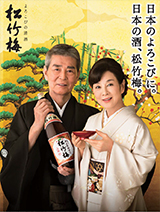
In 2018, on the strengths of Sho Chiku Bai's positioning as a sake for special occasions and celebrations and the promotion of comprehensive sake development for both home and outside consumption, Takara Shuzo jumped to first place in terms of domestic shipment volume of sake.
-

2020
-
Establishment of a long-term management plan, TaKaRa Group Challenge for the 100th
In 2020, Takara Group established a long-term management plan, TaKaRa Group Challenge for the 100th (TGC100), covering the six-year period ending March 2026, its 100th anniversary. TGC100 upholds "Smiles in Life" as the Takara Group’s vision. To achieve this vision, the Takara Group has established a management policy to achieve sustainable growth and major advances while strengthening its presence in Japan and overseas by further improving its technological, product, and brand capabilities and providing diverse value in the Japanese alcoholic beverages and Japanese food markets and the life science industry. The company has also established the Takara Group Sustainability Policy, which presents the Takara Group's approach to social and environmental issues.
2021
-
Efforts to combat COVID-19
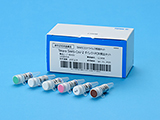
The novel coronavirus disease (COVID-19), which began at the end of 2019, has caused a global pandemic. Under this critical situation, the Group concentrated its efforts on business activities. In particular, Takara Bio worked toward the resolution of social issues by developing a PCR test kit that can detect the novel coronavirus directly from saliva, setting up a stable production and supply system, and cooperating in the development of a vaccine against the novel coronavirus. (The photo shows a novel coronavirus PCR detection kit (in vitro diagnostic product).)
-

2021
-
Reorganization of global manufacturing system

In 2020, the Center for Gene and Cell Processing II, one of our CDMO production bases for regenerative medicine, cell therapy, and gene therapy products, was completed and began operations.
Furthermore, in 2021, Takara Bio USA, Inc. (photo right) was relocated to San Jose, a city in the heart of Silicon Valley, underwent a facilities expansion, and newly began manufacturing reagent products, as part of a strategy to optimize the efficiency of the entire group by decentralizing and reorganizing manufacturing operations in Japan, the U.S., China, and Europe. -

-
-
4
